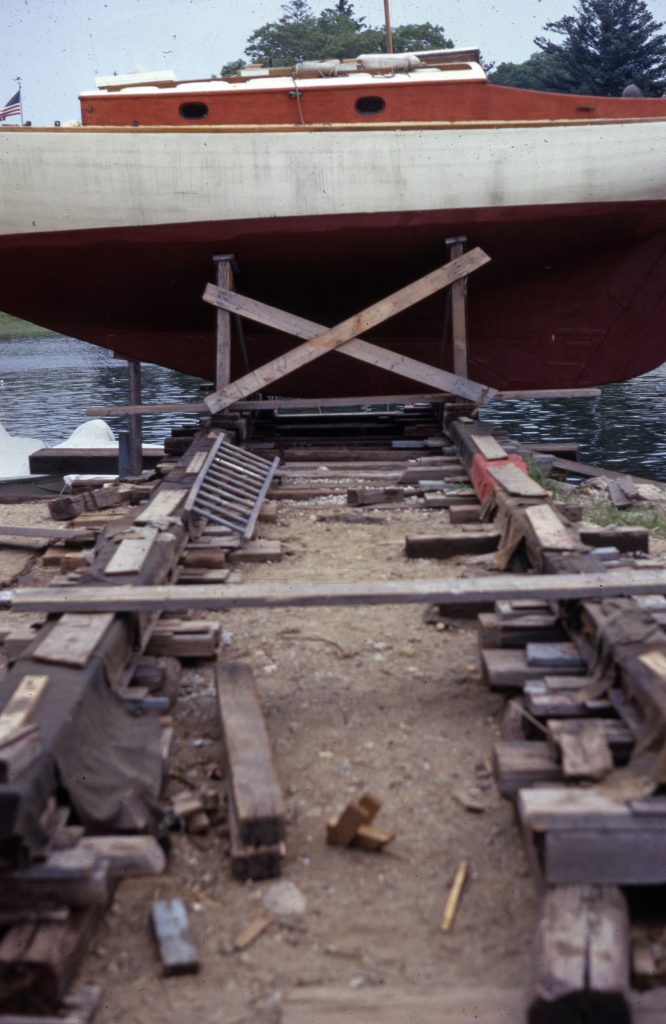There was a time when I loved to roam around boatyards. Back then I was always keeping an eye out for the boat of my dreams. Perhaps an old Atkin cutter or Friendship sloop that somebody left behind. Of course, it would have a for-sale sign on it with a price that would be ridiculously low. Years ago, I did come across that boat. I didn’t buy her but that is another story. However, I have to admit that today the old thrill I used to get walking around boatyards is gone.
I grew up working in boatyards. It was a great summer job for a kid in New England in the sixties. Of course, working in boatyards back then was a lot different than it is today. There were no travel lifts or hydraulic equipment. The first “open-end” straddle mobile boat hoist, today commonly referred to as a travel lift, came out in 1957 and it quickly changed the industry. The boatyards I worked in used marine railways for larger boats and cranes and hoists for smaller ones. The saying was, “first in, last out.” because the last boat you hauled out on the railway had to be the first one back in the water. It took a lot of planning and limited what you could do.

Another big difference was that most of the boats we maintained were constructed of wood. The first fiberglass sailboat auxiliary was built around 1951 and by the sixties, the production of fiberglass boats had really taken off. Although there’s been a recent resurgence in wooden boat construction, they are still uncommon. I’m not sure why but to me wooden boats seem to have a bit more soul. Some old-timers still refer to them as Clorox bottles and while many fiberglass boats are attractive, they seem a bit cold, like a girl I once knew.
One of the big selling points for fiberglass boats was that they required very little maintenance compared to wooden boats but I always enjoyed working on them more than fiberglass boats. The main reason is that epoxy resin is toxic and working with it requires protective gear. Let’s compare it to working in wood. The fresh smell of cedar and the feel of old comfortable hand tools compared to working in a protective suit with a full respirator in ninety-degree heat, the resin mix starting to go off, sweat blinding you, no thanks. Many skilled workers I’ve known became sensitized to epoxy and had to go into other lines of work.
Boatyards which used to be, at least to my eye, visually appealing have become an insult to our senses with the extensive use of white shrink wrap. This bright shiny plastic used for storing boats, instead of traditional canvas that weathers to a soft gray in the sun, has created an industrial landscape.
Old boatyards had another thing that is sadly lacking today, colorful characters. I’ve run into a lot of them. Many were retired sailors and seamen who instead of going into a home as they got old would find an old scow somewhere in a backwater to live out the remainder of their days in peace regaling the local kids, including me, with tales of adventure.
Even the sounds of the modern boatyard have changed. Where are the days of hemp halyards gently tapping on their wooden masts? Back in the day mornings were quiet. You could hear the chirping of wooden blocks as big mainsails were raised. You could hear the splash of fish chasing bait and the cry of gulls overhead. Not anymore. With the advent of modern power tools, a mechanized army is on the attack; grinding, sawing, sanding, drilling, assaulting the stubborn fiberglass hulls, and drowning out any other sounds except for the always present portable radio blasting the latest pop tune. At night the noise made by the clanging of halyards banging against aluminum masts in the wind is enough to send even the hard of hearing to the liquor locker for a double ration of grog.
So, my friends, I have the boatyard blues. If, like me, you miss the way boatyards used to be in the good old days I have a few suggestions. Have a can of Stockholm tar, Balsam gum turpentine, or boiled linseed oil nearby to get that authentic smell. Find an old boat and reef out some seams or do some caulking, plying your mallet with the dexterity of a concert percussionist until your muscles ache. If you’re really feeling nostalgic scrape the paint off the bottom until you’re covered in red dust. Cut some cedar with a hand saw and throw the shavings into a pot belly stove. Perhaps you could whip a few lines with some tarred hemp marlin while whistling a sea shanty. Remember to do your washing up with a bar of pine tar soap and finish with some Old Spice or Bay Rum cologne. Finally, pour yourself a ration of grog with dark rum, that way you’ll at least feel and smell like you’ve been at the real thing.
